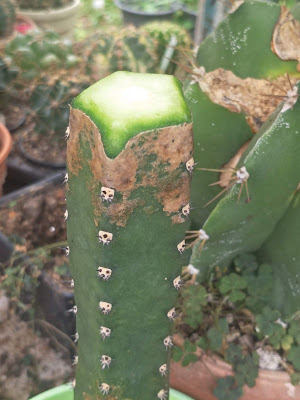Gymnocalycium horstii Growing Guide
Two days ago, wife bought me a cactus for my upcoming birthday!
She ia totally not into cactus at all, so it is once in the blue moon kind of behavior for her to do this.
Anyway, it is a mature specimen sized Gymnocalycium horstii or also known as Gymnocalycium buenekeri.
This time, I will share a brief guide on how to care for G. horstii.
Basically, G. horstii is commonly called as "spider cactus", this is due to its spider like spines.
Description: G. horstii is a distinctive large cactus, minimally spined with a green ball-shaped body. Usually solitary or slowly clustering as they age.
Stem: smooth, globoid, shiny green, up to 20(-25) cm in diameter.
Ribs: 5-6 cm wide, rounded, somewhat acute, deeply furrowed.
Spines: Few (usually 5 of which one pointing downward others to the sides) , yellowish white, sparse, straight to slightly curved, definite and very irregular, up to 3 cm long.
Flowers: White, pale pink, pink or pale purplish up to 11 cm long and in diameter.
Fruits: Ovoid, blue-green
Remarks: Gymnocalycium buenekeri and G. horstii are very similar if not identical, both have very similar great pink flowers and the same (usually) five ribbed appearance, and good yellow spines
Cultivation: Very easy to grow, this plants offers no cultivation difficulties.
Watering: Summer grower needs moderate to copious waterings in summer. Once a week is reccomended for temperate climate.
Temperature: Quite frost resistant if kept dry in winter -4° C. Min temp is 10° C and optimal is 24-26° C.
Fertilizer: Feed with a high potassium fertilizer in summer.
Sun Exposure: Full sun to light shade
Repotting: every 36 months or when pot is full.
Propagation: can be grown from offsets. Fresh seeds germinate well and seedling grow on a vigorous rate.
Two days ago, wife bought me a cactus for my upcoming birthday!
She ia totally not into cactus at all, so it is once in the blue moon kind of behavior for her to do this.
Anyway, it is a mature specimen sized Gymnocalycium horstii or also known as Gymnocalycium buenekeri.
This time, I will share a brief guide on how to care for G. horstii.
Basically, G. horstii is commonly called as "spider cactus", this is due to its spider like spines.
Description: G. horstii is a distinctive large cactus, minimally spined with a green ball-shaped body. Usually solitary or slowly clustering as they age.
Stem: smooth, globoid, shiny green, up to 20(-25) cm in diameter.
Ribs: 5-6 cm wide, rounded, somewhat acute, deeply furrowed.
Spines: Few (usually 5 of which one pointing downward others to the sides) , yellowish white, sparse, straight to slightly curved, definite and very irregular, up to 3 cm long.
Flowers: White, pale pink, pink or pale purplish up to 11 cm long and in diameter.
Fruits: Ovoid, blue-green
Remarks: Gymnocalycium buenekeri and G. horstii are very similar if not identical, both have very similar great pink flowers and the same (usually) five ribbed appearance, and good yellow spines
Cultivation: Very easy to grow, this plants offers no cultivation difficulties.
Watering: Summer grower needs moderate to copious waterings in summer. Once a week is reccomended for temperate climate.
Temperature: Quite frost resistant if kept dry in winter -4° C. Min temp is 10° C and optimal is 24-26° C.
Fertilizer: Feed with a high potassium fertilizer in summer.
Sun Exposure: Full sun to light shade
Repotting: every 36 months or when pot is full.
Propagation: can be grown from offsets. Fresh seeds germinate well and seedling grow on a vigorous rate.






























































